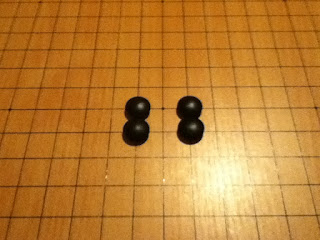The proverb is a very important one. It's not easy coping with loss.
There are cases, however, of games which you both win and learn from. Today, I had such a game. Ironically, it is these sorts of games that are even harder to cope with than lost ones. I feel very little joy over today's win. Let us at least maximise the "learn" part, then.
2012-08-05-Median-player123.sgf
It was a handicap game. The first and most important lesson from this game is that two stones is really not that much, and when you feel you have done enough to be ahead, you should *stop panicking*. I'll get back to this lesson at the important point in the game.
We started off casually. I tried to use sente-retaining opening moves. I remained as high as possible, and loose. I tried not to get too attached to anything from the get-go.
He used a very strange variation in the upper right corner. He did get more thickness than usual, but his shape is pretty bad. I was certain I could harass that later on, so this was probably his first mistake. Also, he never really got to use that thickness to much effect.
The rest of the fuseki is ok, I guess. Now that I have the whole game in view, I would swap my 39 for J16. Other than that, I'm satisfied. Still, I (now) feel that after J17 I've evened the board out. Another move at around L13 would be perfect at that point. However, he started an invasion in the lower right, and I felt that I should handle that first, and leave the center for later.
The attachment at 41 was probably a mistake. I was still panicking about this being a handicap game, and felt that I need to kill something in the lower right to have a playable game. I succeeded, but only because he didn't know what the ladder was... After that, killing the rest came easy.
Now, I feel that I would swap 87 K11 for L13.
Then comes the most important part. D6 may be OK, but it is a product of me still being in the "this is a handi game!" mindset. I should have just calmly responded with E5 and avoided complications. This led to me losing a pretty large group for no good reason, and allowing him a small intrusion into my territory. BTW, I think that E6 would be much better at G6. Thoughts?
At 165, I should have went another step on the third line before going down to second. I'll remember that. I made another critical mistake at 183. That cut should have waited, and I needed to cover up F15. The opponent resigned at 187, but he still could have played F15, and I'm pretty sure that the game would have went easily to his favor if he only saw that.
So, in retrospect, the important lessons were:
There are cases, however, of games which you both win and learn from. Today, I had such a game. Ironically, it is these sorts of games that are even harder to cope with than lost ones. I feel very little joy over today's win. Let us at least maximise the "learn" part, then.
2012-08-05-Median-player123.sgf
It was a handicap game. The first and most important lesson from this game is that two stones is really not that much, and when you feel you have done enough to be ahead, you should *stop panicking*. I'll get back to this lesson at the important point in the game.
We started off casually. I tried to use sente-retaining opening moves. I remained as high as possible, and loose. I tried not to get too attached to anything from the get-go.
He used a very strange variation in the upper right corner. He did get more thickness than usual, but his shape is pretty bad. I was certain I could harass that later on, so this was probably his first mistake. Also, he never really got to use that thickness to much effect.
The rest of the fuseki is ok, I guess. Now that I have the whole game in view, I would swap my 39 for J16. Other than that, I'm satisfied. Still, I (now) feel that after J17 I've evened the board out. Another move at around L13 would be perfect at that point. However, he started an invasion in the lower right, and I felt that I should handle that first, and leave the center for later.
The attachment at 41 was probably a mistake. I was still panicking about this being a handicap game, and felt that I need to kill something in the lower right to have a playable game. I succeeded, but only because he didn't know what the ladder was... After that, killing the rest came easy.
Now, I feel that I would swap 87 K11 for L13.
Then comes the most important part. D6 may be OK, but it is a product of me still being in the "this is a handi game!" mindset. I should have just calmly responded with E5 and avoided complications. This led to me losing a pretty large group for no good reason, and allowing him a small intrusion into my territory. BTW, I think that E6 would be much better at G6. Thoughts?
At 165, I should have went another step on the third line before going down to second. I'll remember that. I made another critical mistake at 183. That cut should have waited, and I needed to cover up F15. The opponent resigned at 187, but he still could have played F15, and I'm pretty sure that the game would have went easily to his favor if he only saw that.
So, in retrospect, the important lessons were:
- Three stones are better than two (on the third line)
- To get ahead, maintain sente and stay light
- Once ahead, calm down

